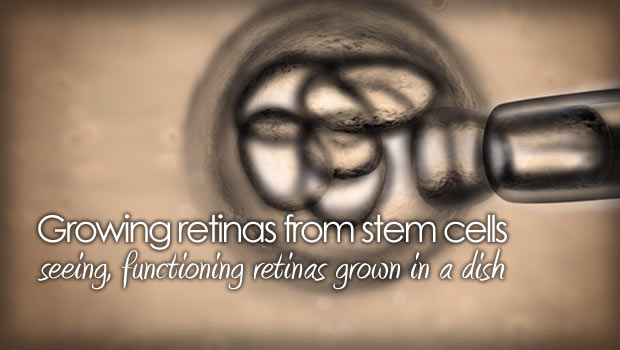Retina tissue grown in a lab from stem cells
Functioning human retina tissue was grown from stem cells in a lab at Johns Hopkins University School of Medicine, according […]


Retina tissue grown in a lab from stem cells
Functioning human retina tissue was grown from stem cells in a lab at Johns Hopkins University School of Medicine, according […]
Functioning human retina tissue was grown from stem cells in a lab at Johns Hopkins University School of Medicine, according to researcher M. Valeria Canto-Soler, Ph.D.
“We created a miniature human retina in a dish”, says Dr. Canto-Soler, assistant professor of ophthalmology at the university. The retina tissue, grown using stem cells, also “has the ability to sense light”, like a functioning retina.
As reported in Nature Communications journal on June 10, 2014, the dish-grown retina tissue has the three-dimensional architecture and ability to recognize light impulses, just as if it were in a human eye.
The retina is the highly sensitive, mostly neuron tissue, lining the back inner wall of the eyeball.
The retina’s function is much like the film in a camera. It is responsible for capturing all of the incoming light rays, processing them into electrical impulses and then sending these signals through millions of nerve fibers to the optic nerve, where they are transmitted to the brain.
When a retina is diseased, as in conditions like retinitis pigmentosa, genetic retina diseases and even macular degeneration, its light-processing ability is greatly diminished. In most cases, once retina neurons are scarred or damaged, they do not recover, so vision symptoms tend to be permanent. The possibility to someday repair or regenerate damaged retina cells is an exciting proposition.
The researchers at Johns Hopkins experimented with human induced pluripotent stem cells (iPS). These are stem cells that have been genetically modified to give them the ability to develop into virtually any of the two-hundred cell types in the human body — in this case, retina photoreceptor cells. Dr. Canto-Soler was actually amazed at how the modified stem cells were able to create a retina “almost on their own”. It seems that “somehow the cells knew what to do.”

The retina is very complex, there are layers that contain pigment cells and membranes that are necessary for vision function and maintenance of the retina as a whole. So far, the Johns Hopkins lab has only been able to grow the top-most, neuron layers of the retina, containing the photoreceptors — or rods and cones. These important cells are the frontline in the process of vision and are a great start if genetically engineered retina cells are going to be a future research tool or treatment for retina disease.
These retina stem cells developments are exciting and promising for many reasons. They have proven that, theoretically, the potential is there to replace damaged and missing retina tissue in advanced cases of retina disease. The ability to genetically manufacture retina tissue will also accelerate many facets of retina research because it will give scientists and lab researchers a stock of lab-grown, living human tissue to experiment with and study closely, rather than using animal models.
It is important to remember that we are a long way from artificially growing and implanting complete, intact retinas. There are many other retina layers and cells that haven’t been lab-grown. Also, methods of implant and sustainability need to be researched and perfected. However, the ease at which the Johns Hopkins researchers were able to manipulate stem cells to grow mini, three-dimensional, functioning retina tissue is a very promising development.
We will continue to closely follow stem cells research here at www.MaculaCenter.com and post new articles frequently.






